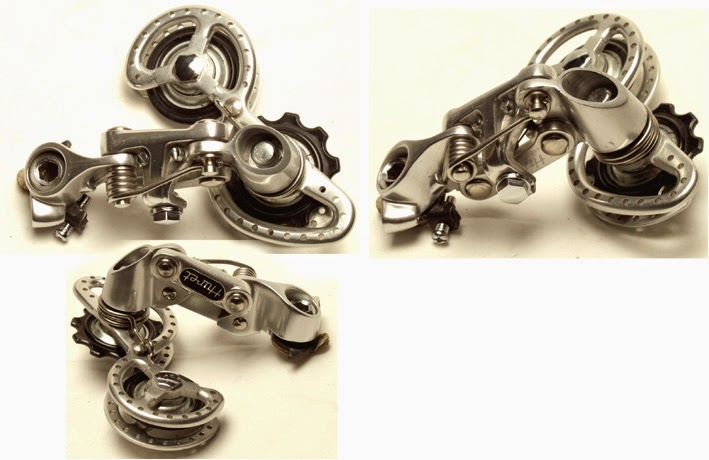It wouldn't surprise you too much to know that one of the blogs on my reading list is Mercian Cycles'.
People are amazed when they find out that I have four Mercians. My usual response usually goes something like, "I'm the luckiest girl in the world."
(All right, now you know where my priorities lie!)
I figured that there are other people who have more Mercians than I do, but I don't know any personally. I'd like to meet them--or look at their collection, anyway!
One such person--or, more appropriately, his bikes--are the subject of today's post on the Mercian Cycles blog.
A fellow named Kyle--who goes by the nom de blog "Retrogrouch"--has just restored a 1980 Strada Speciale with period-correct parts, including a first-generation SunTour Cyclone derailleur, Simplex retrofriction levers, milled Sugino Mighty cranks with "drillium" chainrings and Campagnolo Nuovo Tipo hubs. This Strada Speciale, he says, is his eighth Mercian.
His collection includes vintage as well as modern models--and a modern bike with vintage Campagnolo parts that looks like a vintage bike. They're all lovely bikes, so it's hard to decide which I liked best.
If you've been following my blog, though, you can probably understand why I like his 2008 Strada Speciale track bike:

or his 2012 Vincitore, built as an urban/path bike:

or, for that matter, his second Mercian, a 1979 "Classic":

I'd love to know how Kyle decides which bike to ride.
People are amazed when they find out that I have four Mercians. My usual response usually goes something like, "I'm the luckiest girl in the world."
(All right, now you know where my priorities lie!)
I figured that there are other people who have more Mercians than I do, but I don't know any personally. I'd like to meet them--or look at their collection, anyway!
One such person--or, more appropriately, his bikes--are the subject of today's post on the Mercian Cycles blog.
A fellow named Kyle--who goes by the nom de blog "Retrogrouch"--has just restored a 1980 Strada Speciale with period-correct parts, including a first-generation SunTour Cyclone derailleur, Simplex retrofriction levers, milled Sugino Mighty cranks with "drillium" chainrings and Campagnolo Nuovo Tipo hubs. This Strada Speciale, he says, is his eighth Mercian.
His collection includes vintage as well as modern models--and a modern bike with vintage Campagnolo parts that looks like a vintage bike. They're all lovely bikes, so it's hard to decide which I liked best.
If you've been following my blog, though, you can probably understand why I like his 2008 Strada Speciale track bike:

or his 2012 Vincitore, built as an urban/path bike:

or, for that matter, his second Mercian, a 1979 "Classic":

I'd love to know how Kyle decides which bike to ride.




-filtered.jpg)

